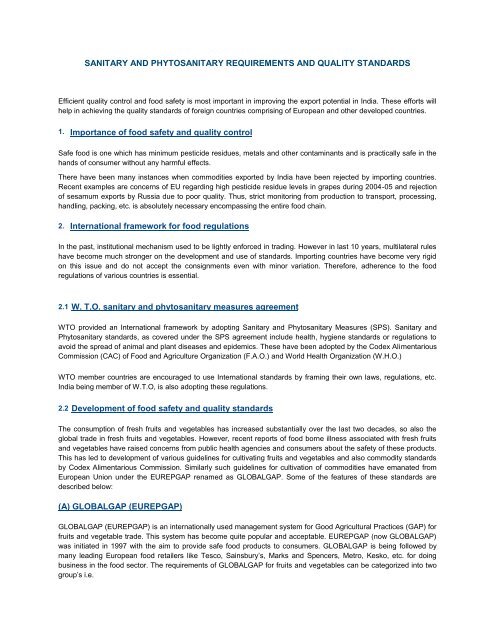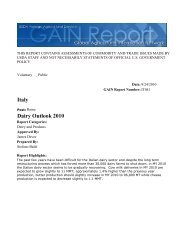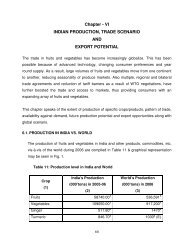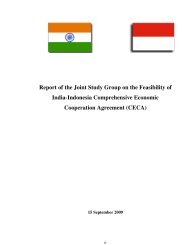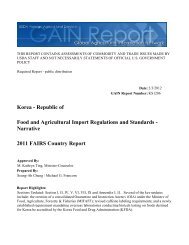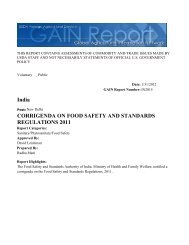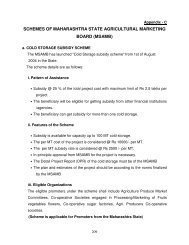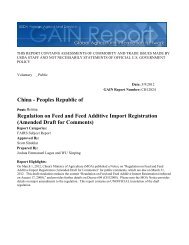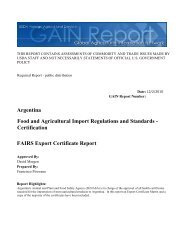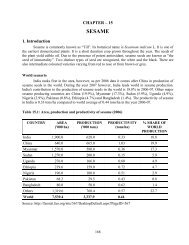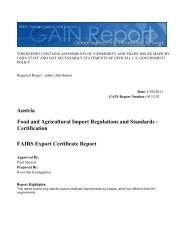Download - APEDA Agriexchange
Download - APEDA Agriexchange
Download - APEDA Agriexchange
Create successful ePaper yourself
Turn your PDF publications into a flip-book with our unique Google optimized e-Paper software.
SANITARY AND PHYTOSANITARY REQUIREMENTS AND QUALITY STANDARDS<br />
Efficient quality control and food safety is most important in improving the export potential in India. These efforts will<br />
help in achieving the quality standards of foreign countries comprising of European and other developed countries.<br />
1. Importance of food safety and quality control<br />
Safe food is one which has minimum pesticide residues, metals and other contaminants and is practically safe in the<br />
hands of consumer without any harmful effects.<br />
There have been many instances when commodities exported by India have been rejected by importing countries.<br />
Recent examples are concerns of EU regarding high pesticide residue levels in grapes during 2004-05 and rejection<br />
of sesamum exports by Russia due to poor quality. Thus, strict monitoring from production to transport, processing,<br />
handling, packing, etc. is absolutely necessary encompassing the entire food chain.<br />
2. International framework for food regulations<br />
In the past, institutional mechanism used to be lightly enforced in trading. However in last 10 years, multilateral rules<br />
have become much stronger on the development and use of standards. Importing countries have become very rigid<br />
on this issue and do not accept the consignments even with minor variation. Therefore, adherence to the food<br />
regulations of various countries is essential.<br />
2.1 W. T.O. sanitary and phytosanitary measures agreement<br />
WTO provided an International framework by adopting Sanitary and Phytosanitary Measures (SPS). Sanitary and<br />
Phytosanitary standards, as covered under the SPS agreement include health, hygiene standards or regulations to<br />
avoid the spread of animal and plant diseases and epidemics. These have been adopted by the Codex Alimentarious<br />
Commission (CAC) of Food and Agriculture Organization (F.A.O.) and World Health Organization (W.H.O.)<br />
WTO member countries are encouraged to use International standards by framing their own laws, regulations, etc.<br />
India being member of W.T.O, is also adopting these regulations.<br />
2.2 Development of food safety and quality standards<br />
The consumption of fresh fruits and vegetables has increased substantially over the last two decades, so also the<br />
global trade in fresh fruits and vegetables. However, recent reports of food borne illness associated with fresh fruits<br />
and vegetables have raised concerns from public health agencies and consumers about the safety of these products.<br />
This has led to development of various guidelines for cultivating fruits and vegetables and also commodity standards<br />
by Codex Alimentarious Commission. Similarly such guidelines for cultivation of commodities have emanated from<br />
European Union under the EUREPGAP renamed as GLOBALGAP. Some of the features of these standards are<br />
described below:<br />
(A) GLOBALGAP (EUREPGAP)<br />
GLOBALGAP (EUREPGAP) is an internationally used management system for Good Agricultural Practices (GAP) for<br />
fruits and vegetable trade. This system has become quite popular and acceptable. EUREPGAP (now GLOBALGAP)<br />
was initiated in 1997 with the aim to provide safe food products to consumers. GLOBALGAP is being followed by<br />
many leading European food retailers like Tesco, Sainsbury’s, Marks and Spencers, Metro, Kesko, etc. for doing<br />
business in the food sector. The requirements of GLOBALGAP for fruits and vegetables can be categorized into two<br />
group’s i.e.
(i) General requirements for all farm based produce<br />
• Record keeping and internal self assessment/inspection.<br />
• Site history and site management.<br />
• Workers health, safety and welfare.<br />
• Waste and pollution management.<br />
• Environment and conservation<br />
• Traceability<br />
(ii)Product specific for fruits and vegetables<br />
• Propagation material<br />
• Soil and sustainable management.<br />
• Irrigation and fertigation<br />
• Harvesting<br />
• Produce handling<br />
GLOBALGAP certification is very important as it not only imparts increased acceptability of the product in foreign<br />
markets, but also leads to reduced cost of production due to lesser use of pesticides, chemicals, etc.<br />
GLOBALGAP has developed a checklist for self assessment purposes. Producers receive their GLOBALGAP<br />
approval by verification by an independent approved body like A.B. Cert, EUROcert, and SGS Agro control. Once<br />
GLOBALGAP criteria are met, a certificate is issued by GLOBALGAP approved certification body.<br />
(B) Codex hygienic practices for fresh fruits and vegetables<br />
Codex Alimentarius Commission has also come forward with guidelines about Good Agricultural Practices (GAP’s)<br />
and Good Manufacturing Practices (GMP’s) that help to control microbial, chemical and physical hazards associated<br />
with all the stages of the production of fresh fruits and vegetables from primary production to packing. It is difficult to<br />
implement these guidelines where primary production is taken up in small holdings. Thus these guidelines are flexible<br />
to allow for different systems of control and prevention of contamination of different groups of commodities. All<br />
aspects like quality of water for irrigation, washing , contamination from unsterlized manures, biosolids, pesticide<br />
residues, safety of agricultural workers, personnel hygiene and sanitary facilities, cleanliness and sanitation of posthandling<br />
equipment, machinery, etc. have been taken into consideration while finalizing the standards.<br />
(C) Codex standards for different fruits and vegetables<br />
Codex Alimentarius Commission has prescribed codex standards for various fruits, vegetables and other<br />
commodities which have been universally accepted.<br />
The codex standards define minimum requirements in form of quality classification details like provisions concerning<br />
sizing and tolerance for sizes and quality, details about marking, labeling and guidance about contaminants, pesticide<br />
residues and hygiene.<br />
(D) HACCP (Hazard Analysis and Critical Control Point) Guidelines<br />
HACCP guidelines are a systematic approach to identifying, evaluating and containing food safety hazards, which<br />
can be biological, chemical or physical agents. Such agents are likely to cause injury in the absence of their control.<br />
HACCP system is a preventive system of hazard control rather than a reactive one and is designed to prevent the<br />
occurrence of potential food safety problems.
Essentially HACCP is a system that identifies and monitors specific food borne hazards that can adversely affect the<br />
safety of the food product. Critical Control Points identify those points in the process that must be controlled to ensure<br />
the safety of food. Monitoring and verification are important steps in HACCP to ensure control of potential hazards.<br />
Principles have been developed which provide guidance for an effective HACCP plan.<br />
(E) Food Safety Management System Certification<br />
International Organization for Standardization (ISO) has published Food Safety Management System and is classified<br />
as ISO 22000. This system promotes FARM TO FORK APPROACH and is the latest and comprehensive food safety<br />
and quality management system. It demonstrates the ability to control food safety hazards and communicates food<br />
safety information throughout the food chain (through traceability) by emphasizing on pre - requisite programmes i.e.<br />
Good Agricultural Practices, Good Manufacturing Practices, and Good Hygienic Practices etc.<br />
ISO 22000 ensures compliance to sanitary requirements, assesses and meets consumer requirements and certifies<br />
that food is safe at the time of consumption. Moreover, Food Safety Management is fully compatible with quality<br />
management system as per ISO 9001-2000.<br />
Full details about Maximum Residue Limits standards for EU, Codex & India and WTO agreement on SPS measures,<br />
GLOBALGAP, Codex hygienic practices for fresh fruits and vegetables, HACCP guidelines, are given in Annexures –<br />
I and II respectively.<br />
(F) GS 1 – Global Traceability Standard<br />
Traceability is the ability to track the movement of food through all the stages of production, processing and<br />
distribution. With this system one can verify inputs used, Lab tests performed, SPS measures adopted, grading and<br />
packing details etc. Many developed countries have built traceability in their food standards.<br />
GS 1 – Global Traceability standard is the most recent standard which is in pipeline for coming into effect from Jan,<br />
2009. This standard mainly emphasizes on critical issues of seamless traceability and may also reach into the<br />
packaging area as is done in HACCP or FSMS (ISO – 22000).<br />
GS 1 is being rapidly adopted by retail chains in Europe. The GS 1 Traceability Standard is a high level description of<br />
the traceability process enabling and promoting supply chain collaboration. At the same time, it allows each company<br />
to design its own traceability system in terms of scope, precision and automation in accordance to its own commercial<br />
objectives.<br />
(G) Other Trends<br />
In European Market, GLOBALGAP certified supplies of fresh fruits and vegetables of conventional (non-organic) type<br />
are coming more and more closer to organic produce, because of ever reducing MRL requirements by the authorities.<br />
3. Status of Food Quality standards in India<br />
India being a member of W.T.O, has adopted sanitary and phytosanitary measures agreement. With our<br />
experience of exports of fruits and vegetables especially to EU countries, India has realized that to stay in the<br />
competitive export market, our exports will have to learn to grapple with existing food standards or else our<br />
farmers run the risk of missing the market access in other countries that guarantees them competitive prices.<br />
Thus, food safety and quality is inevitable for export market. Few years back, our export of apple to SAARC<br />
countries dwindled mainly because of supply of better quality apples (properly graded, shining and having<br />
attractive appearance) made available by Australia, USA and New Zealand. available by Australia, USA and New<br />
Zealand. Moreover, Indian consumers too deserve safe quality food. WTO’s National Treatment Principle revents<br />
us from enforcing standards on imported goods in the absence of similar domestic standards and because of this<br />
consumers and farmers run the risk of being dumped with cheap and sub-standard food products. Indian<br />
consumers are also getting quality conscious and demand for quality food is increasing. If domestic standards are
not improved, the upcoming retail chains like Reliance, Spencer’s, etc. may prefer to source their products<br />
through imports to meet the growing demand of quality food and as a result of which Indian farmer would suffer<br />
not being competitive. India has started making sincere efforts to improve upon quality standards of farm produce<br />
for boosting exports. The measures taken in this direction are given below:<br />
(A) Adoption of Quality standards<br />
India has accepted the importance of quality standards for different commodities among fresh fruits and vegetables<br />
and even Govt. of India has been participating in the meetings of Codex Alimentarius Commission for consideration<br />
of draft proposals of different commodities, so that various features and required parameters pertaining to Indian<br />
products are incorporated in the final version of quality standards. Recently, various standards applicable for exports<br />
of fresh fruits and vegetables have been notified under AGMARK Act and have been named under title of GRADE<br />
DESIGNATION AND QUALITY. These standards under Agmark Act have been prepared keeping Codex Standards<br />
as a base. These updated standards are available with www.agmarknet.nic.in to exporters for improving quality of<br />
produce for exports.<br />
(B) Adoption of GLOBALGAP<br />
GLOBALGAP – Good Agricultural Practices are being widely adopted by the growers, GAP (Good Agricultural<br />
Practices) eliminates food safety hazards from indiscriminate use of farm inputs, besides ensuring compliance with<br />
hygienic measures, personnel hygiene, environment protection and pest control.<br />
Even many well known exporters in India like M/s FreshTrop Fruits Limited, Nashik and FieldFresh of M/s Bharti<br />
Enterprises Limited, Ludhiana are encouraging farmers (who supply fruits and vegetables) to have GLOBALGAP<br />
certification. Many farmers in the ambit of FieldFresh and FreshTrop have received GLOBALGAP certification<br />
especially who supply grapes and pomegranate for export from Maharashtra and also who supply freshvegetables for<br />
export from Punjab.<br />
Indian farmers and exporters were initially apprehensive about EUREPGAP certification but compliance to it has<br />
significantly increased India’s grape export and improved the unit price realization.<br />
Further, GLOBALGAP certification has been so much appreciated at all levels that a draft IndiaGAP programme<br />
designed in consultation with various stakeholders is under consideration. The IndiaGAP programme is dovetailed to<br />
Indian conditions and seeks to encourage farmers to constantly upgrade their infrastructure and agricultural practices.<br />
In the long run, IndiaGAP too would need to be harmonized with globally accepted norms as that of GLOBALGAP to<br />
avoid multiple audits.<br />
(C) Adoption of Traceability<br />
India has realized the importance of traceability, after EU raised concerns over high pesticide residue levels in grapes<br />
and adoption of traceability was initiated in Indian grapes in 2006. This has improved the confidence of importing<br />
countries in our agri products. It also helps to do away with repeat testing of products in importing countries. Because<br />
of above facts traceability is quickly percolating in other fruits and vegetables.<br />
(D) Adoption of Food Safety Management System certification<br />
FSMS certification scheme has already been accepted by Bureau of Indian Standards. In due course it will be put into<br />
place at levels like exporters, packers, etc.
4. Initiative from <strong>APEDA</strong><br />
<strong>APEDA</strong> has also been taking various steps for promotion of quality and its control. <strong>APEDA</strong> provides assistance in the<br />
form of subsidy up to 25% for setting up laboratories for analyzing quality parameters like pesticide residue, metal<br />
content, etc. <strong>APEDA</strong> also promotes quality control by giving 50 % subsidy for installing quality management, quality<br />
assurance and quality control systems such as ISO series, HACCP and GAP Certification.<br />
5. Certification Facilities<br />
With the awareness on importance of quality control especially pesticide residue, more and more farmers are<br />
registering with GLOBALGAP. Facilities for GLOBALGAP Certification are available at a number of locations<br />
(Annexure–III).<br />
This has resulted in registration of more and more grape and pomegranate farmers in Maharashtra. Similarly,<br />
registration of contract farmers (supplying vegetables to Field Fresh) is rapidly increasing and becoming quite popular<br />
in Ludhiana / Ladowal region of Punjab. Also facilities for testing for pesticide residues are now available in almost all<br />
states (Annexure- III).


